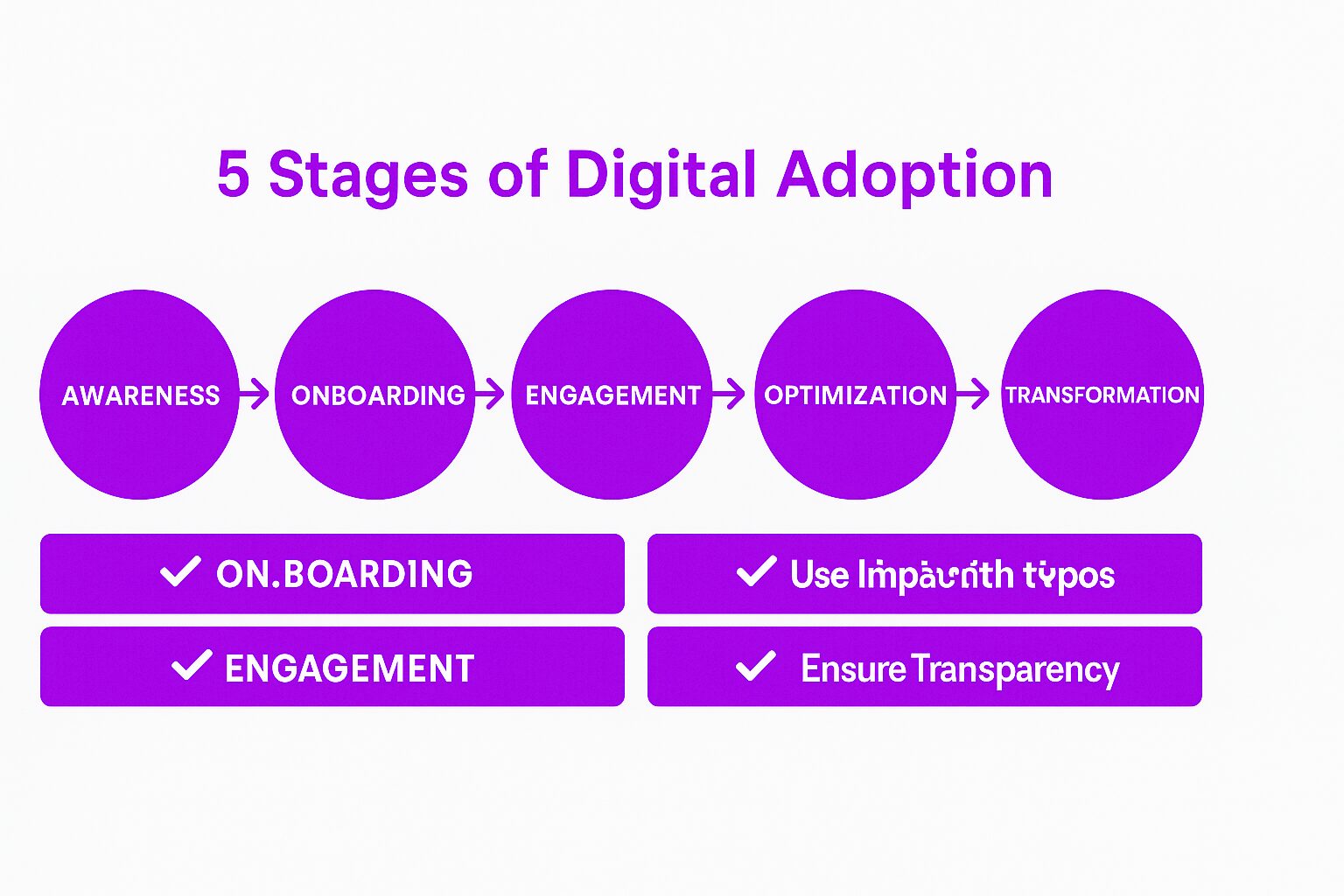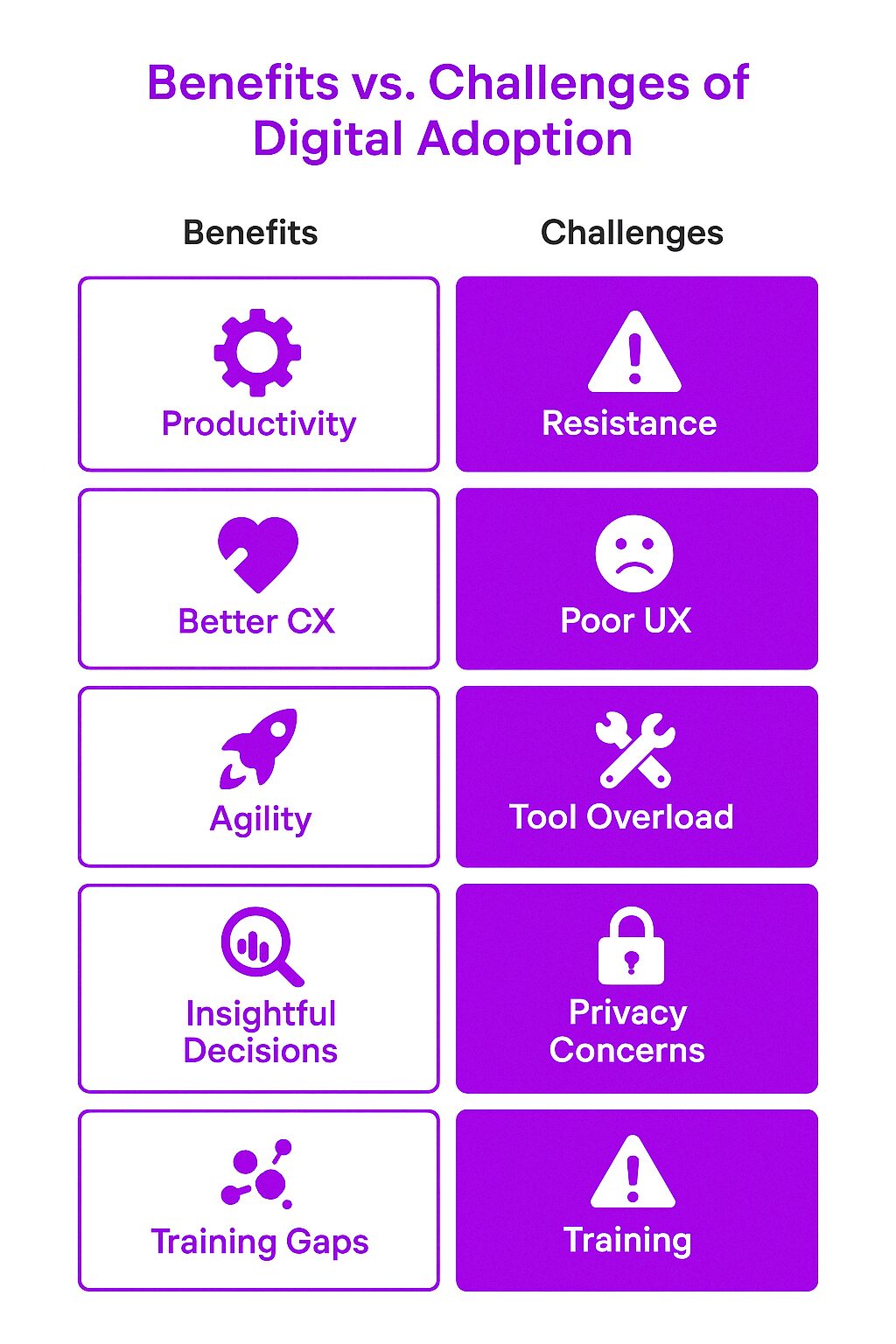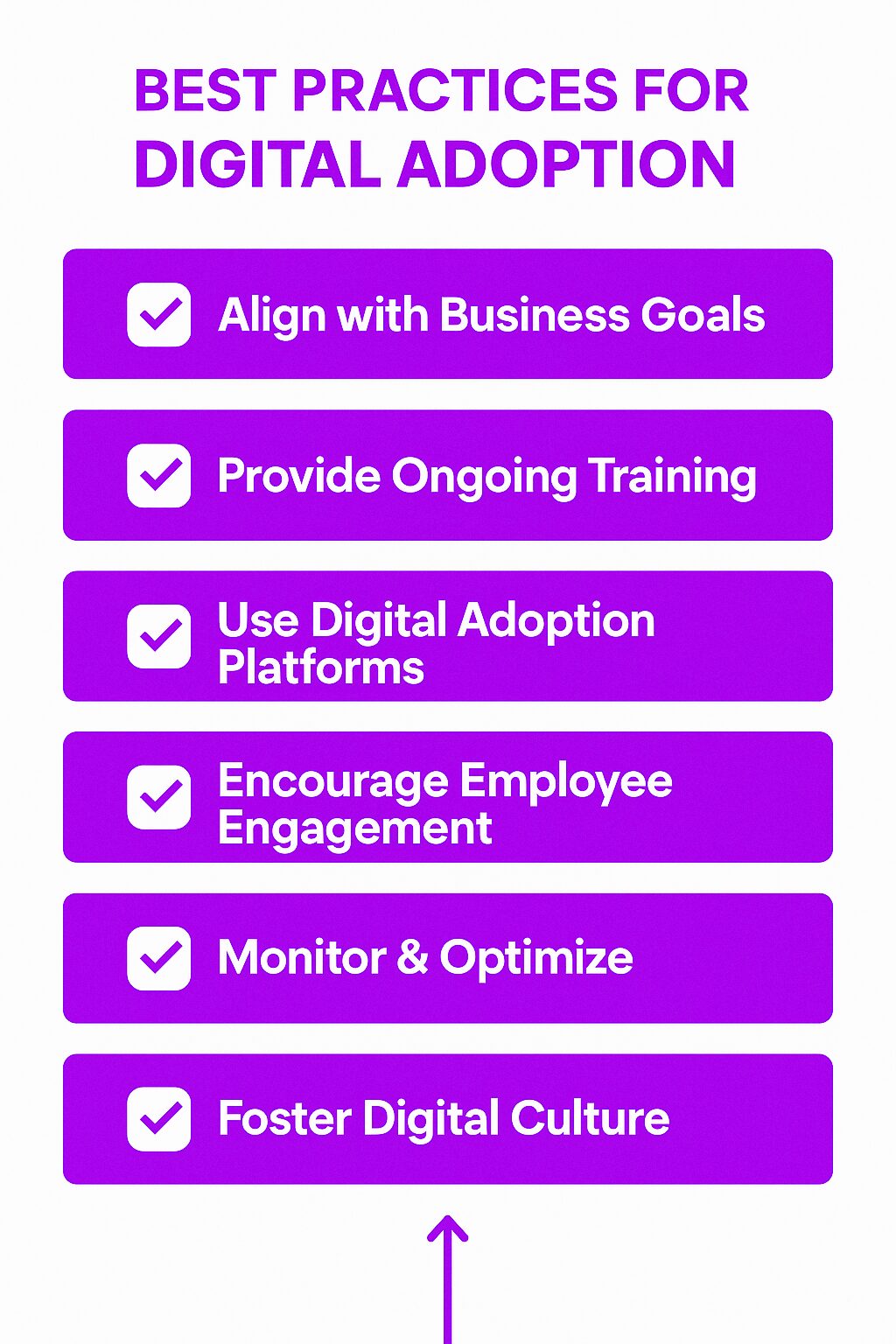What Is Digital Adoption?
Digital adoption is the process of fully integrating digital tools into an organization’s workflows so that employees, customers, and stakeholders can use them effectively. This integration is part of the broader digital adoption revolution, which emphasizes the need for businesses to leverage digital tools and technologies effectively to stay competitive. It goes beyond simply implementing software—it ensures that users understand and utilize the technology to its full potential, driving productivity and business outcomes.
When digital adoption is successful, employees maximize the value of digital tools, improving efficiency and collaboration. Customers benefit from better experiences, and organizations see higher returns on technology investments. Without adoption, new software and systems become underutilized, leading to wasted resources and frustration.
How Digital Adoption Works
Digital adoption happens when technology becomes an integral part of daily operations, making tasks easier and more efficient. A digital adoption platform provides guidance and support, helping users navigate through various applications. In-app guidance can help users navigate digital platforms more effectively by offering contextual support directly within the software. It requires a combination of user training, ongoing support, and a company-wide culture that encourages technology use. Organizations that focus on digital adoption ensure that employees and customers are comfortable navigating digital platforms, reducing inefficiencies and increasing engagement.
Digital adoption is different from digital transformation. While digital transformation focuses on implementing new technologies to change business processes, digital adoption ensures that those technologies are used effectively. A successful digital adoption strategy turns digital investments into productivity gains, rather than just adding more tools to the workflow.
Key Stages of Digital Adoption
1. Awareness
Users become aware of new digital tools and their potential benefits. This stage involves communicating why the technology is being introduced and how it will improve work processes.
2. Onboarding
Users receive initial training on how to use the software. Onboarding can include guided tutorials, hands-on demonstrations, and knowledge-sharing sessions. Implementing in-app guidance can enhance the onboarding process by providing real-time support and reducing training times.
3. Engagement
Employees begin to interact with the technology regularly. Encouraging engagement involves addressing pain points, refining workflows, and providing support.
4. Optimization
Users integrate the technology into their daily tasks. At this stage, feedback loops help identify areas for improvement and additional training needs.
5. Transformation
Technology becomes second nature, and employees use it to drive business innovation. At this point, digital tools are fully embedded in workflows, enhancing efficiency and decision-making.
Why Digital Adoption Matters
Organizations invest in digital tools to improve operations, but without proper adoption, those investments don’t deliver value. Digital adoption ensures that employees fully use the available technology, leading to better business outcomes.
Tracking digital adoption success through key metrics and gathering feedback is essential to assess satisfaction, usability, and impact, ensuring the intended benefits of digital transformation are achieved.
Key Reasons Digital Adoption Is Essential
-
Maximizing ROI on Technology Investments: Companies spend billions on software, but without adoption, much of that investment is wasted.
-
Boosting Employee Productivity: When employees understand how to use digital tools, they complete tasks faster and with fewer errors.
-
Enhancing Collaboration: Digital adoption improves communication across teams, especially in remote and hybrid work environments.
-
Improving Customer Experience: Customers benefit from smoother digital interactions, leading to higher satisfaction and loyalty.
-
Ensuring Business Agility: Companies that successfully adopt digital tools can quickly adapt to changes in the market.
Benefits of Digital Adoption
1. Increased Productivity
New digital technologies help employees focus on their core tasks by reducing the time spent troubleshooting software. Automation and AI-powered tools help reduce manual work.
2. Faster Employee Onboarding
With strong digital adoption strategies, new hires get up to speed quickly, reducing training time and improving retention. Organizations can drive digital adoption by implementing user guidance, leveraging analytics, and providing continuous support to ensure effective use of digital tools and accelerate the onboarding process.
3. Improved Decision-Making
When employees effectively use digital tools, they can access real-time data and analytics, leading to smarter business decisions.
4. Greater Business Agility
Organizations with strong digital adoption can quickly implement new technologies, respond to industry shifts, and maintain a competitive edge.
5. Enhanced Customer Satisfaction
Companies that adopt digital tools effectively provide better customer service, faster response times, and more seamless digital experiences.
Challenges of Digital Adoption
1. Resistance to Change
Employees may be reluctant to adopt new tools, especially if they feel comfortable with existing systems.
2. Lack of Proper Training
If employees don’t receive adequate training, they may struggle to use new technology, leading to frustration and inefficiencies.
3. Overwhelming Number of Tools
Too many digital tools can lead to “tool fatigue,” making it harder for employees to integrate them into their workflows.
4. Data Privacy and Security Concerns
As organizations adopt digital tools, they must ensure that sensitive data is protected and that users are aware of cybersecurity best practices.
5. Poor User Experience
If the technology is not intuitive, employees may resist using it. Poorly designed interfaces or complex workflows can slow down adoption.
Analyzing user behavior is crucial to enhance user experience and improve adoption rates.
Best Practices for Digital Adoption
1. Align Digital Tools with Business Goals
Technology should solve real business problems rather than being implemented for the sake of modernization. Identify key pain points and select tools that directly address them.
2. Provide Ongoing Training and Support
One-time training sessions are not enough. Organizations should offer continuous education through video tutorials, Q&A sessions, and hands-on demonstrations.
3. Leverage Digital Adoption Platforms (DAPs)
DAPs provide real-time guidance within digital tools, reducing the learning curve and improving adoption rates.
An enterprise digital adoption platform is crucial for enhancing digital adoption strategies for major brands and companies, maximizing technology investments and improving the overall adoption process.
4. Encourage Employee Engagement
Getting employees involved in the selection and implementation of digital tools increases buy-in and reduces resistance.
5. Monitor and Optimize
Use analytics to track tool usage, gather feedback, and make necessary adjustments to improve the user experience.
6. Foster a Culture of Digital Innovation
Organizations should encourage employees to explore and experiment with new technologies, creating an environment where digital tools are seen as enablers rather than burdens.
Digital Adoption Strategies
Digital adoption strategies are crucial for organizations to maximize the use of digital tools and technologies. A well-planned digital adoption strategy can help organizations achieve successful digital adoption, which is essential for driving digital transformation efforts. Here are some effective digital adoption strategies that organizations can use:
Related Concepts
Digital Transformation vs. Digital Adoption
-
Digital Transformation focuses on integrating digital technology into all aspects of a business.
-
Digital Adoption ensures that employees effectively use these technologies. True digital adoption occurs when users are fully capable of navigating and utilizing a digital product’s features in their daily tasks, which is crucial for integrating technology into organizational workflows and ensuring both employees and customers embrace these tools.
Technology Adoption Lifecycle
-
Early adopters embrace new technology quickly, while late adopters require more support and training.
Change Management in Digital Adoption
-
Effective change management strategies help ease transitions and increase adoption rates.
Real-World Examples of Digital Adoption
1. Hybrid Work Environments
Companies that successfully implemented collaboration tools like Microsoft Teams and Slack saw improved communication and productivity in remote settings.
2. AI-Powered Employee Experience Platforms
Organizations that leverage digital technologies and AI-driven insights have reported higher engagement with digital tools and better decision-making.
3. Retail and E-commerce
Retailers that streamlined payment systems and inventory tracking through digital adoption improved customer satisfaction and operational efficiency.
4. Healthcare Industry
Hospitals that implemented telemedicine services and electronic health records improved patient care and reduced administrative workloads.
Additionally, digital adoption trends in the healthcare industry are significantly enhancing patient care and administrative efficiency.
Final Thoughts
Digital adoption is essential for organizations looking to maximize the value of their technology investments. When employees and customers fully integrate digital tools into their workflows, businesses see improvements in productivity, agility, and customer experience.
By providing the right training, fostering a culture of digital engagement, and continuously refining adoption strategies, companies can ensure that their digital transformation efforts deliver real, lasting value.







